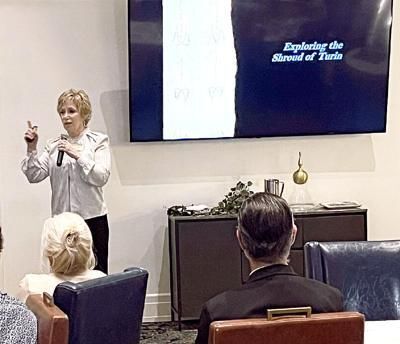
JUPITER | For about 30 years, the Shroud of Turin has fascinated Cheryl White, a history professor at Louisiana State University-Shreveport, who spoke June 13, 2023, at a dinner meeting of the Jupiter/Palm Beach chapter of Legatus. Those who care to think about the purported burial cloth of Jesus are left with only two conclusions, she said.
“It’s not like there’s a long list of things it can be. Nobody ever looks at this linen and says, ‘Who is that supposed to be?’ Or, ‘Gosh, who is that? Who is this crucified, scourged man pierced on the right side?’ Nobody says that. There’s no question who it is,” she told the Legatus group.
The main question is this: What is it? The first conclusion is that it’s the authentic burial linen of Christ, and the image on the cloth was created in some way that can’t be duplicated in the 21st century, said White, who serves on the board of the Shroud of Turin Education and Research Association.
“It’s either that or it is an ancient or medieval artwork,” she said. “And it is an ancient or medieval artwork created by someone, an unknown artist, who had advanced knowledge of human anatomy, blood-splatter forensics and negative photography, 800 years before it was invented. It’s one of these two things. It’s not anything else.”
Legatus, an organization for Catholic business executives and their spouses, began its event with the sacrament of reconciliation, recitation of the rosary and Mass, celebrated by Father Frank D’Amato, chaplain of the Jupiter/Palm Beach chapter and parochial vicar at St. Jude in Tequesta, moving July 1 to St. Helen in Vero Beach.
As stated on the Legatus website, member benefits include: spiritual and professional support at chapter and national meetings, retreats, webinars, pilgrimages and special gatherings, and fellowship among other Catholics with like-minded values. Members are encouraged to commit to attending Mass and praying the rosary every day and going to confession monthly.
Introducing White at the recent meeting, chapter president David Thompson said that she is scheduled to give a presentation on the Shroud of Turin at World Youth Day in Lisbon in August. Besides her shroud research, White said she chairs the historical commission for the canonization cause of five Louisiana priests who died during the 1873 yellow fever epidemic in Shreveport. On June 15, the U.S. bishops affirmed their support for advancing the cause.
Speaking to the Legatus group, White said the only time the Shroud of Turin was scientifically examined was in 1978. In the early 1980s, when that research began to be published, she was a college undergraduate and newly baptized Catholic. She was pulled into the story of the shroud, and it has never let her go.
“Right up until last year when I had the incredible privilege of being in Turin with a small group and got to spend about an hour with the cloth,” said White, who has presented original research on the linen and served as a consultant on the shroud exhibit at the Museum of the Bible in Washington. “I can tell you that whatever anyone thinks about this cloth, it does not leave anyone indifferent. And I don’t know many things in the material world we can say that about.”
Part of the mystery that draws people to the shroud is its relatively short, documented history. Though the shroud became known only in the middle of the 14th century, it doesn’t mean that it was created then, she said. That was when a chapel was built by a knight in France to house the cloth, which was put on public display.
In 1453, the shroud became the possession of the European royal family of Savoy, whose last member, former King Umberto II of Italy, died in 1983. He willed the cloth to the individual who was pope, not the institutional Catholic Church, White said. Another stipulation was that the shroud could never leave Turin, where it is in the Cathedral of St. John the Baptist.
In 1532, White said a fire damaged the shroud, leaving scorch marks on the linen, but not affecting the image. Two years later, nuns repaired the upper left corner of the cloth, introducing new cotton fibers to the old linen, she said. The location of the repair is important because, after six samples of the cloth were taken in 1988, a team of scientists proclaimed that the cloth was a medieval hoax no older than from the 13th century.
However, in 2019, when raw data from the 1988 carbon dating study was examined, it was found that the samples taken by the scientists were all from the upper left corner of the cloth. “Even I know that’s not the same thing as taking six samples,” White said. “But that’s what they did. And this has been published. It’s out there. We know that we’re now dealing with the very real possibility that this could be a much older linen.”
Seeing the cloth last year, she said, “I was struck by its beauty. The beauty of the weave, the beauty of the linen itself. The perfection of that weave is just incredible craftsmanship. It’s remarkable, making it unlike anything medieval I’d ever seen.”
The scientific team from 1978 found that “they knew of no method or process in the early 1980s that would account for the image,” White said. They said there were no dyes, paints or pigments of any kind, and it wasn’t a photograph or artwork. The man in the image is 5 feet, 10 inches tall, about 165 pounds. The left wrist is pierced, with large wounds at the feet.
There are more than 360 identifiable wounds made by the same weapon in strikes of three, inflicted by two men on each side, one taller than the other, the scientists found. The man, with blood type AB, was pierced on the right side between the fifth and sixth ribs, and had more than 100 puncture wounds from something thorny on his head.
“I don’t know if you know anything about Eucharistic miracles, but this is the same blood type as every studied Eucharistic miracle,” White said.
With the level of analysis that the shroud has undergone, she said, it is normal to expect answers. “Application of our reason leads us to inquiry. It leads us to study, it leads us to know, and objects of the material world always give up their secrets to us, don’t they? Because we’re going to figure them out. If man makes something, man can understand it.
“The Shroud of Turin is the inverse of that,” White said. “It’s actually the opposite of the way academic inquiry works. The more we study it, the more questions we have. The deeper we are pulled into mystery. Every time we answer a question, we’re confronted with — guess what? — all sorts of new questions. And that’s been the story of my life with this particular linen.”
To apply for Legatus membership, applicants must meet certain criteria, such as being a Catholic in good standing; holding the top position at a qualifying company, subsidiary or division (chairman, president, CEO, managing director, division head, owner); with at least 40 employees or a payroll of $1.5 million; and revenue of at least $8 million, or $2 million for financial or commission-based client services. Potential members can apply on the www.Legatus.org website or contact the Legatus affiliate. Contact membership chair Erin Nickler at ekaynick@bellsouth.net.
Pictured:
Cheryl White, history professor at Louisiana State University-Shreveport, talks about the Shroud of Turin, which she has studied for many years, to members of Legatus June 13, 2023.

